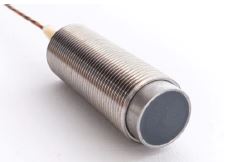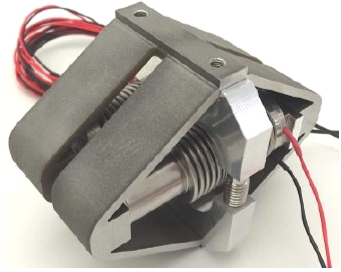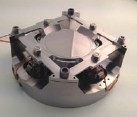Publications
Categories
- (34)
- (9)
- (3)
- (145)
- (18)
- (7)
- (5)
- (8)
- (9)
- (17)
- (2)
- (104)
- (7)
- (15)
- (7)
- (2)
- (1)
- (6)
- (155)
- (20)
- (2)
- (5)
- (111)
- (35)
- (11)
- (4)
- (59)
- (18)
- (3)
- (7)
- (62)
- (18)
- (5)
- (24)
- (7)
- (12)
- (1)
- (2)
- (2)
- (1)
- (1)
- (14)
- (13)
- (4)
- (6)

Cost efficient space micro-switch based on Contactless Eddy Current Sensor
8 September 2022
Micro-switches are frequently used in Space mechanisms to provide telemetry or to provide positive indication of the achievement of a desired position or function such as open, close, ready-to-latch, latched, end of travel, reference position, and for different mechanism applications. Current switches that rely on electro-mechanical technology are not very reliable and are sensitive to mounting orientation, to thermal gradients, and have a limited number of operational cycles, which is a problem for long life application, launch vibrations and shocks loads.

Amplified Piezo Actuator APA® with viscoelastic material for machine tool semi active damping system
8 January 2016
Modern machine tools must achieve a high precision for a better surface texture and higher flexibility for wide range of machining requirements. To fulfill these requirements, a semi-active damping system for a new generation of machine tools is proposed. The new concept is partially based on the Amplified Piezo Actuators APA® from CEDRAT Technologies. With these actuators, the dynamic behavior (stiffness and damping) of structural body components of machine tools can be controlled and adjusted to the optimum parameters. To reduce the transfer of vibrations through the active elements, a viscoelastic material was used. This article presents test results performed on the APA® with viscoelastic material. A significant reduction of the vibrational amplitude at resonance frequency was observed with additional material. The optimized quantity of viscoelastic
material reduces the full stroke of the actuator only by 10 percent. At the same time, the viscoelastic material has reduced the amplitude at resonance frequency by more than double. The designed actuator obtains a blocking force of 8.5kN. Results obtained from the tests performed on the machine tool showed significant surface texture improvement with use of the amplified piezoelectric actuator.

M2EMS Miniature magnetic rotating motor
19 June 2023
Thanks to the help of intensive modelling, the two first prototypes realised in the framework of the M2 EMS project are functional. It consists of prototypes of single-phase stepper motor whose structure has been transformed from the Lavet motor so as to take into account collective production of the magnet film layers, which are developed in the M2 EMS project.

Structural damage identification
19 June 2023
This paper presents two approaches for structural damage identification, each based on a different philosophy. The Virtual Distortion Method is a model-updating method of damage assessment, utilizing gradient-based optimization techniques to solve the resulting inverse dynamic problem in the time domain. Case-Based Reasoning is a soft-computing method utilizing wavelet transformation for signal processing and neural networks for training a base of damage cases to use for retrieving a similar relevant case.

Amplified piezo actuators enhancement for active vibration control
7 June 2018
Amplified Piezo Actuators (APA®) from CEDRAT TECHNOLOGIES are known to be compact and especially performing in dynamic applications. The recent evolutions realized on the APA® and drive electronics allow them to address active damping better than magnetic proof mass in terms of the Force to Volume ratio above some 10Hz. The dynamic capability of the APA® has been improved thanks to preload method enhancement. Research has successfully shown the possibility to achieve a high dynamic force level similar to the static blocked force of the piezo actuator. This technical progress coupled with an amplified motion makes possible the generation of high mechanical proof mass load at relatively low frequency. It produces a force higher than 100N in a volume of Ø40x75mm within a range of [100-300Hz]. This paper presents relevant uses of APA® for active damping in machining applications. Several machining case studies are reported integrating Amplified Piezo
Actuators within the spindle head, inside the cutting tool or beside the workpiece clamp.

Cryogenic piezo characterisation and integration For Fine Steering Tip/Tilt Mechanism
19 June 2023
High precision cryogenic applications are demanding domains that require precise knowledge of component performance. In the case of active components such as piezoelectric actuators, such knowledge includes stroke, capacitance and Coefficient of Thermal Expansion (CTE). These parameters are difficult to define with precision because of the combination of small displacements and low temperature sensor compatibilities. A high stability and low sensibility test bench is required to obtain such results


